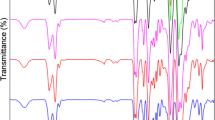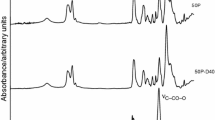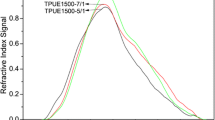Abstract
The pliability of polymers is contingent on its architecture, decided by its stoichiometry, which is also an expedient way to ensure the anticipated characteristics in polymers. Four series of linear polyurethane elastomers, each comprised of seven samples are synthesized using hydroxyl terminated polybutadiene as macrodiol, toluene diisocyanate and four different chain extenders: 1, 2 Ethane diol; 1, 4 Butane diol; 1, 6 Hexane diol and 1, 8 Octane diol. The functional linkages for the development of polymers have been confirmed via Fourier transform infrared spectroscopy. Hydrogen bonding index calculated from vibrational modes of C = O group are obtained in the range of 1.08–1.394. The thermal stability is observed up to 290 °C by thermal gravimetric analysis. Swelling behavior showed 50% of industrial waste water uptake. The true tensile strength is observed up to 8.48 MPa with 1,4 butane diol as chain extender. The secant modulus at 1% strain rate is found in the range of 0.30 to 12 MPA. The maximum value of toughness is observed as 3.26 J-mm−2 for 1,4 butane diol chain extender. Scanning electron microscopic analysis has revealed morphological phase segmentation based on composition.








Similar content being viewed by others
References
Han X, Guo Z (2021) Graphene and its derivative composite materials with special wettability: Potential application in oil-water separation. Carbon 172:647–681
Xiang D, Liu L, Liang Y (2017) Effect of hard segment content on structure, dielectric and mechanical properties of hydroxyl-terminated butadiene-acrylonitrile copolymer-based polyurethane elastomers. Polym 132:180–187
Ponnamma D, Yin Y, Salim N (2021) Recent progress and multifunctional applications of 3D printed graphene nanocomposites. Compos B Eng 204:108493
Akram N, Zia KM, Saeed M, Mansha A, Khan WG (2018) Morphological studies of polyurethane based pressure sensitive adhesives by tapping mode atomic force microscopy. J Poly Res 25:194
Delpech MC, Miranda GS (2012) Waterborne polyurethanes: influence of chain extender in ftir spectra profiles Cent. Eur J Eng 2:231–238
Wang Y, Zhou W, Cao K, Hu X, Gao L, Lu Y (2021) Structural Impact of Graphene Nanoribbon on Mechanical Properties and Anti-corrosion Performance of Polyurethane Nanocomposites. Chem Eng J 405:126858
Singh AK, Mehra DS, Niyogi UK, Sabharwal S, Khandal KR (2012) Shrinkage studies in electron beam curable polyuretane pressure-sensitive adhesive Radiat. Phys Chem 81:547–552
Akram N, Zia KM, Saeed M, Usman M, Khan WG (2019) Role of isophorone diisocyanate in the optimization of adhesion tendency of polyurethane pressure sensitive adhesives. J Appl Polym Sci 136:47124
Moon JI, LeeYH KHJ, Schwartz S, Rafailovich M, Sokolov, (2012) Investigation of the peel test for measuring self-cleanable characteristic of fluorine-modified coatings. J Polym Testing 31:433–438
Joo H, Cho S (2020) Comparative studies on polyurethane composites filled with polyaniline and graphene for DLP-type 3D printing. Polym 121:67
NaeemM KHC, Michelmore A, Ma J (2020) A new method for preparation of functionalized graphene and its epoxy nanocomposites. Compos B Eng 1961:108096
Akram N, Zia KM, Sattar R, Tabassum S, Saeed M (2019) Thermomechanical investigation of hydroxyl-terminated polybutadiene-based linear polyurethane elastomers. J Appl Polym Sci 136:47289
Mahmood K, Zia KM, Aftab W, Zuber M, Tabasum S, Noreen A, Zia F (2018) Synthesis and characterization of chitin/curcumin blended polyurethane elastomers Intl. J Biol Macromol 113:150–158
Agirre A, Nase J, Degrandi E, Creton C, Asua JM (2010) Improving adhesion of acrylic waterborne PSAs to low surface energy materials: Introduction of stearyl acrylate. J Polym Sci Part A: Polym Chem 48:5030–5039
Chiang WK, Ghassemieh E, Lewis R, Rowson J, Thompson C (2010) Comparison of tack of pressure-sensitive adhesives (PSAs) at different temperatures. J Adhesion Sci Tech 24:1949–1957
Akram N, Zia KM, Saeed M, Usman M, Saleem S (2018) Impact of macrodiols on the adhesion strength of polyurethane pressure-sensitive adhesives. J Appl Polym Sci 135:46635
Hung P, Lau K, Fox B, Hameed N, Lee J, Hui D (2019) Surface modification of carbon fibre using graphene–related materials for multifunctional composites Compos. B Eng 133:240–257
Akram N, Zia KM, Saeed M, Usman M, Khan WG, Bashir MA (2019) Investigation of non-adhesive behaviour of waterborne polyurethane dispersions. Poly Res 26:45
Akram N, Gurney RS, Keddie JL, Zuber M, Ishaq M (2013) Influence of Polyol molecular and type on the tack and peel properties of waterborne polyurethane pressure-sensitive adhesives. Macromol React Eng 7:493
Beatriz L, José LDLF (2014) Rheokinetic analysis on the formation of metallo-polyurethanes based on hydroxyl-terminated polybutadieneEuro. Polym J 50:117–126
Tarek M, Madkour RAA (2013) Non-Gaussian behavior of self-assembled thermoplastic polyurethane elastomers synthesized using two-step polymerization and investigated using constant-strain stress relaxation and molecular modeling techniques. Euro Polym J 49:439–451
Daoudi A, Perraton D, Dony A, Carter A (2020) From Complex Modulus E* to Creep Compliance D(t): Experimental and Modeling Study Mater.13:1945. https://doi.org/10.3390/ma13081945
Špírková M, Pavličević J, Strachota A, Poreba R, Bera O, Kaprálková L, Baldrian J, Šlouf M, Lazić L, Simendić JB (2011) Novel polycarbonate-based polyurethane elastomers: Composition–property relationship Euro. Polym J 47:959–972
HaoYM ZL, Lih ST, Yugang S, Shaoqin G (2014) Silver nanowire/thermoplastic polyurethane elastomer nanocomposites: Thermal, mechanical, and dielectric properties Mat. Desig 56:398–404
Peng W, Dietmar A, Eckart U, Georg G, Manfred HW (2019) Rheological and Mechanical Gradient Properties of Polyurethane Elastomers for 3D-Printing with Reactive Additives. Appl Rheol 29:162–172
Wang P, Auhl D, Uhlmann E, Gerlitzky G, Wagner MH (2019) Rheological and Mechanical Gradient Properties of Polyurethane Elastomers for 3D-Printing with Reactive Additives. Appl Rheol 29(1):162–172
Fan J, Chen A (2019) Studying a Flexible Polyurethane Elastomer with Improved Impact-Resistant Performance. Polym 11(3):467
Jeevan J, Abhishek KA (2020) EMI shielding and dynamic mechanical analysis of graphene oxide-carbon nanotube-acrylonitrile butadiene styrene hybrid composites. Polym Test 91:106839
Oprea S, Timpu D, Oprea V (2019) Design-properties relationships of polyurethanes elastomers depending on different chain extenders structures. J Polym Res 26:117
Kojio K, Mutsuhisa F, Yoshiteru N, Sadaharu N (2010) Control of Mechanical Properties of Thermoplastic Polyurethane Elastomers by Restriction of Crystallization of Soft Segment. Materials 3:5097–5110
Zia KM, Barikani M, Zuber M, Bhatti IA, Bhatti HN (2008) Morphological Studies of Polyurethane Elastomers Extended with α, ω Alkane Diols. Iran Polym J 17(1):61–72
Mashhadi MM, Lopes CS, Lorca LJ (2018) Modelling of the mechanical behavior of polyurethane foams by means of micromechanical characterization and computational homogenization. Int J Solids Struct 146:154–166
McKeen P (2019) Liao Z (2019) Pyrolysis model for predicting the fire behavior of flexible polyurethane foam. Build simul 12:337–345
Jouibari IS, Asl VH, Mirhosseini MM (2019) A novel investigation on micro-phase separation of thermoplastic polyurethanes: simulation, theoretical, and experimental approaches. Iran Polym J 28:237–250
Menon A, James A, Colón T, Washburn NR (2019) Hierarchical machine learning model for mechanical property predictions of polyurethane elastomers from small datasets front. Mater Sci 6(87):1–12
Chen CP, Dai SA, Chang HL, Su WC, Wu TM, Jeng RJ (2005) Polyurethane elastomers through multi-hydrogen-bonded association of dendritic structures. Polym 46:11849–11857
Lee DW, Kim HN, Lee DS (2019) Introduction of reversible urethane bonds based on vanillyl alcohol for efficient self-healing of polyurethane elastomers. Molecules 24:2201
Cao H, Qi F, Liu R, Wang F, Zhang C, Zhang X, Chai Y, Zhai L (2017) The influence of hydrogen bonding on Nmethyldiethanolamine- extended polyurethane solid–solid phase change materials for energy storage. RSC Adv 7:11244
Ourique PA, Ornaghi FG, Ornaghi HL Jr, Wanke CH, Bianchi O (2019) Thermo-oxidative degradation kinetics of renewable hybrid polyurethane–urea obtained from air-oxidized soybean oil. J Therm Anal Calorim 137:1969–1979
Gadgeel AA, Mhaske ST (2020) Synthesis and characterization of UV curable polyurethane acrylate derived from ɑ-Ketoglutaric acid and isosorbide. Prog Org Coat 150:105983
Chattopadhyay DK, Webster DC (2009) Thermal stability and flame retardancy of polyurethanes. Prog Polym Sci 34(10):1068–1133
Silva JEE, Alarcon RT, Gaglieri C, Magdalena AG, Silva-Filho LC, Bannach G (2018) New thermal study of polymerization and degradation kinetics of methylene diphenyl diisocyanate. J Therm Anal Calorim 133:1455–1462
Naheed S, Zuber M, Barikani M, Salman M (2021) Molecular engineering and morphology of polyurethane elastomers containing various molecular weight of macrodiols. Molecular engineering and morphology of polyurethane elastomers containing various molecular weight of macrodiols, Materials science and Engineering : B 264:114960
Akram N, Saeed M, Usman M, Mansha A, Anjum F, Zia KM, Mahmood I, Mumtaz N, Khan WG (2021) Influence of graphene oxide contents on mechanical behavior of polyurethane composites fabricated with different diisocyanates. Polymers 30; 13(3):444
Author information
Authors and Affiliations
Corresponding author
Additional information
Publisher's Note
Springer Nature remains neutral with regard to jurisdictional claims in published maps and institutional affiliations.
Supplementary Information
Below is the link to the electronic supplementary material.
Rights and permissions
About this article
Cite this article
Akram, N., Saleem, S., Zia, K.M. et al. Stoichiometric-architectural impact on thermo-mechanical and morphological behavior of segmented Polyurethane elastomers. J Polym Res 28, 238 (2021). https://doi.org/10.1007/s10965-021-02566-2
Received:
Accepted:
Published:
DOI: https://doi.org/10.1007/s10965-021-02566-2




